Healthcare Record Keeping and Reporting: Technologies and Processes
VerifiedAdded on 2020/12/29
|8
|2077
|282
Report
AI Summary
This report provides a comprehensive overview of healthcare record keeping and reporting practices. It begins by highlighting the importance of accurate record keeping in healthcare settings and then delves into the use of technology, such as digital software, electronic health records, and telemedicine, to improve efficiency and accuracy. The report also emphasizes the benefits of involving service users in record-keeping processes, including increased transparency and improved patient-carer relationships. It further explores standard record formats for different service users and examines various aspects of managing service user records, including data protection and monitoring activities. The report concludes by summarizing the key findings and advocating for the adoption of advanced digital systems and service user involvement to enhance the quality of healthcare record keeping.

HOW HEALTHCARE
SETTINGS RECORD AND
REPORT
SETTINGS RECORD AND
REPORT
Paraphrase This Document
Need a fresh take? Get an instant paraphrase of this document with our AI Paraphraser
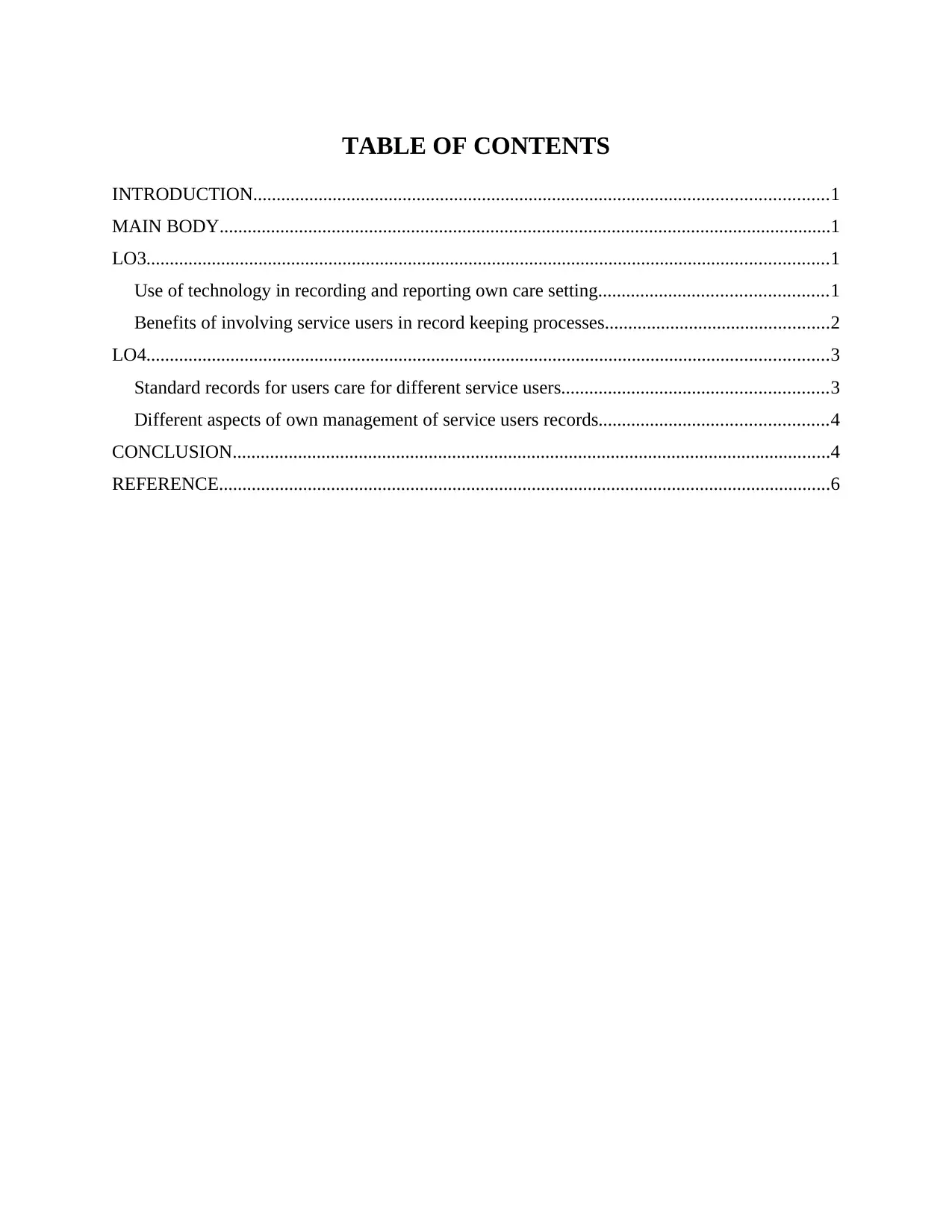
TABLE OF CONTENTS
INTRODUCTION...........................................................................................................................1
MAIN BODY...................................................................................................................................1
LO3..................................................................................................................................................1
Use of technology in recording and reporting own care setting.................................................1
Benefits of involving service users in record keeping processes................................................2
LO4..................................................................................................................................................3
Standard records for users care for different service users.........................................................3
Different aspects of own management of service users records.................................................4
CONCLUSION................................................................................................................................4
REFERENCE...................................................................................................................................6
INTRODUCTION...........................................................................................................................1
MAIN BODY...................................................................................................................................1
LO3..................................................................................................................................................1
Use of technology in recording and reporting own care setting.................................................1
Benefits of involving service users in record keeping processes................................................2
LO4..................................................................................................................................................3
Standard records for users care for different service users.........................................................3
Different aspects of own management of service users records.................................................4
CONCLUSION................................................................................................................................4
REFERENCE...................................................................................................................................6
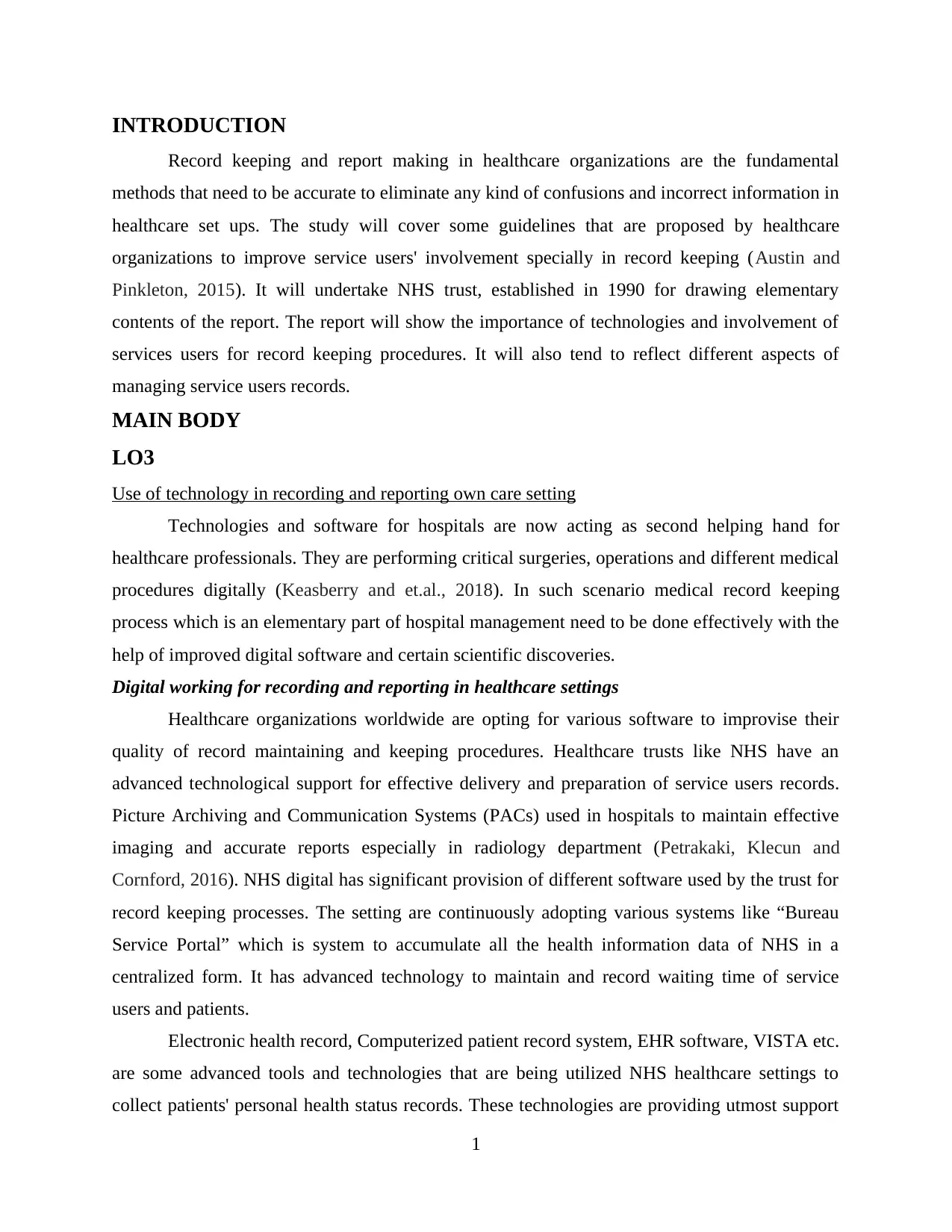
INTRODUCTION
Record keeping and report making in healthcare organizations are the fundamental
methods that need to be accurate to eliminate any kind of confusions and incorrect information in
healthcare set ups. The study will cover some guidelines that are proposed by healthcare
organizations to improve service users' involvement specially in record keeping (Austin and
Pinkleton, 2015). It will undertake NHS trust, established in 1990 for drawing elementary
contents of the report. The report will show the importance of technologies and involvement of
services users for record keeping procedures. It will also tend to reflect different aspects of
managing service users records.
MAIN BODY
LO3
Use of technology in recording and reporting own care setting
Technologies and software for hospitals are now acting as second helping hand for
healthcare professionals. They are performing critical surgeries, operations and different medical
procedures digitally (Keasberry and et.al., 2018). In such scenario medical record keeping
process which is an elementary part of hospital management need to be done effectively with the
help of improved digital software and certain scientific discoveries.
Digital working for recording and reporting in healthcare settings
Healthcare organizations worldwide are opting for various software to improvise their
quality of record maintaining and keeping procedures. Healthcare trusts like NHS have an
advanced technological support for effective delivery and preparation of service users records.
Picture Archiving and Communication Systems (PACs) used in hospitals to maintain effective
imaging and accurate reports especially in radiology department (Petrakaki, Klecun and
Cornford, 2016). NHS digital has significant provision of different software used by the trust for
record keeping processes. The setting are continuously adopting various systems like “Bureau
Service Portal” which is system to accumulate all the health information data of NHS in a
centralized form. It has advanced technology to maintain and record waiting time of service
users and patients.
Electronic health record, Computerized patient record system, EHR software, VISTA etc.
are some advanced tools and technologies that are being utilized NHS healthcare settings to
collect patients' personal health status records. These technologies are providing utmost support
1
Record keeping and report making in healthcare organizations are the fundamental
methods that need to be accurate to eliminate any kind of confusions and incorrect information in
healthcare set ups. The study will cover some guidelines that are proposed by healthcare
organizations to improve service users' involvement specially in record keeping (Austin and
Pinkleton, 2015). It will undertake NHS trust, established in 1990 for drawing elementary
contents of the report. The report will show the importance of technologies and involvement of
services users for record keeping procedures. It will also tend to reflect different aspects of
managing service users records.
MAIN BODY
LO3
Use of technology in recording and reporting own care setting
Technologies and software for hospitals are now acting as second helping hand for
healthcare professionals. They are performing critical surgeries, operations and different medical
procedures digitally (Keasberry and et.al., 2018). In such scenario medical record keeping
process which is an elementary part of hospital management need to be done effectively with the
help of improved digital software and certain scientific discoveries.
Digital working for recording and reporting in healthcare settings
Healthcare organizations worldwide are opting for various software to improvise their
quality of record maintaining and keeping procedures. Healthcare trusts like NHS have an
advanced technological support for effective delivery and preparation of service users records.
Picture Archiving and Communication Systems (PACs) used in hospitals to maintain effective
imaging and accurate reports especially in radiology department (Petrakaki, Klecun and
Cornford, 2016). NHS digital has significant provision of different software used by the trust for
record keeping processes. The setting are continuously adopting various systems like “Bureau
Service Portal” which is system to accumulate all the health information data of NHS in a
centralized form. It has advanced technology to maintain and record waiting time of service
users and patients.
Electronic health record, Computerized patient record system, EHR software, VISTA etc.
are some advanced tools and technologies that are being utilized NHS healthcare settings to
collect patients' personal health status records. These technologies are providing utmost support
1
⊘ This is a preview!⊘
Do you want full access?
Subscribe today to unlock all pages.

Trusted by 1+ million students worldwide

to the MRD in hospitals. Apart from this, Telemedicine and Telediagnosing are another
advanced technological supports that are being facilitating the report making of different hospital
departments. Along with it, Digital NHS has a developed system for E-prescription for service
users and patients.
Benefits of technologies in record keeping
Implementation of various technologies and software for record keeping have not only
reduced the paper work but also minimize the threat of losing and misplacement of the manual
records within hospital premises. Apart from this, digital record keeping procedures in healthcare
set up increases patient's awareness related to their own health status (Scott, Sullivan and Staib,
2018). E-prescription are continuously reducing the paper or manual work and maintain stock
controls. Other related service users like health researchers received smooth access data for
health status survey of country.
Benefits of involving service users in record keeping processes
Record keeping processes in healthcare set up is a crucial method performed by all
healthcare personnel at every point of contact with patients or service users (Grundy and et.al.,
2016). Healthcare team are responsible to maintain high level of accuracy for developing
standardized patients' records.
National Institute of Health and Care Excellence have designed certain policies for
service user involvement and since a considerable time frame NICE has involving service users
in its different procedures (Good Practice in Service User Involvement Training, 2015).
Healthcare trust and organizations of NHS has followed the guidelines of NICE for Public
involvement and service users engagements in the development and maintenance of records.
Healthcare organizations may increase the quality of their medical records by involving
patients and service users in its record keeping processes. Various details can be accumulated by
visitors and sufferers to know the loopholes of existing services. This involvement and
engagement of patients, visitors and family members increases the quality of assessments.
Hospitals must follow certain protocols to increases service users' participation for receiving
credible parameters to evaluate and increase existing reporting and recording methods.
Service users' involvement increases the transparency between carers and patients which
improves carer patients' relationship. It can deliver easy and approachable solutions for general
problems faced during record keeping and development processes. This involvement of service
2
advanced technological supports that are being facilitating the report making of different hospital
departments. Along with it, Digital NHS has a developed system for E-prescription for service
users and patients.
Benefits of technologies in record keeping
Implementation of various technologies and software for record keeping have not only
reduced the paper work but also minimize the threat of losing and misplacement of the manual
records within hospital premises. Apart from this, digital record keeping procedures in healthcare
set up increases patient's awareness related to their own health status (Scott, Sullivan and Staib,
2018). E-prescription are continuously reducing the paper or manual work and maintain stock
controls. Other related service users like health researchers received smooth access data for
health status survey of country.
Benefits of involving service users in record keeping processes
Record keeping processes in healthcare set up is a crucial method performed by all
healthcare personnel at every point of contact with patients or service users (Grundy and et.al.,
2016). Healthcare team are responsible to maintain high level of accuracy for developing
standardized patients' records.
National Institute of Health and Care Excellence have designed certain policies for
service user involvement and since a considerable time frame NICE has involving service users
in its different procedures (Good Practice in Service User Involvement Training, 2015).
Healthcare trust and organizations of NHS has followed the guidelines of NICE for Public
involvement and service users engagements in the development and maintenance of records.
Healthcare organizations may increase the quality of their medical records by involving
patients and service users in its record keeping processes. Various details can be accumulated by
visitors and sufferers to know the loopholes of existing services. This involvement and
engagement of patients, visitors and family members increases the quality of assessments.
Hospitals must follow certain protocols to increases service users' participation for receiving
credible parameters to evaluate and increase existing reporting and recording methods.
Service users' involvement increases the transparency between carers and patients which
improves carer patients' relationship. It can deliver easy and approachable solutions for general
problems faced during record keeping and development processes. This involvement of service
2
Paraphrase This Document
Need a fresh take? Get an instant paraphrase of this document with our AI Paraphraser
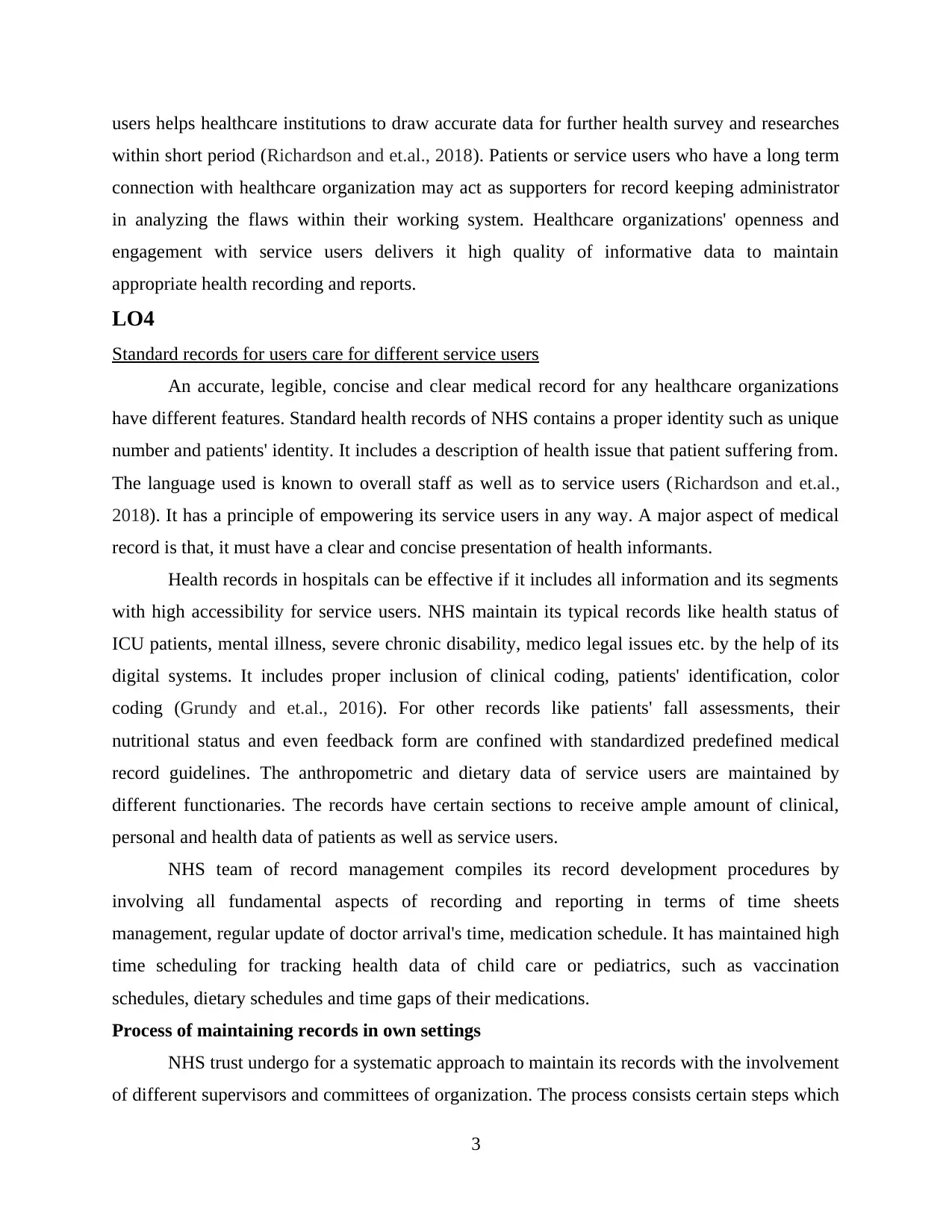
users helps healthcare institutions to draw accurate data for further health survey and researches
within short period (Richardson and et.al., 2018). Patients or service users who have a long term
connection with healthcare organization may act as supporters for record keeping administrator
in analyzing the flaws within their working system. Healthcare organizations' openness and
engagement with service users delivers it high quality of informative data to maintain
appropriate health recording and reports.
LO4
Standard records for users care for different service users
An accurate, legible, concise and clear medical record for any healthcare organizations
have different features. Standard health records of NHS contains a proper identity such as unique
number and patients' identity. It includes a description of health issue that patient suffering from.
The language used is known to overall staff as well as to service users (Richardson and et.al.,
2018). It has a principle of empowering its service users in any way. A major aspect of medical
record is that, it must have a clear and concise presentation of health informants.
Health records in hospitals can be effective if it includes all information and its segments
with high accessibility for service users. NHS maintain its typical records like health status of
ICU patients, mental illness, severe chronic disability, medico legal issues etc. by the help of its
digital systems. It includes proper inclusion of clinical coding, patients' identification, color
coding (Grundy and et.al., 2016). For other records like patients' fall assessments, their
nutritional status and even feedback form are confined with standardized predefined medical
record guidelines. The anthropometric and dietary data of service users are maintained by
different functionaries. The records have certain sections to receive ample amount of clinical,
personal and health data of patients as well as service users.
NHS team of record management compiles its record development procedures by
involving all fundamental aspects of recording and reporting in terms of time sheets
management, regular update of doctor arrival's time, medication schedule. It has maintained high
time scheduling for tracking health data of child care or pediatrics, such as vaccination
schedules, dietary schedules and time gaps of their medications.
Process of maintaining records in own settings
NHS trust undergo for a systematic approach to maintain its records with the involvement
of different supervisors and committees of organization. The process consists certain steps which
3
within short period (Richardson and et.al., 2018). Patients or service users who have a long term
connection with healthcare organization may act as supporters for record keeping administrator
in analyzing the flaws within their working system. Healthcare organizations' openness and
engagement with service users delivers it high quality of informative data to maintain
appropriate health recording and reports.
LO4
Standard records for users care for different service users
An accurate, legible, concise and clear medical record for any healthcare organizations
have different features. Standard health records of NHS contains a proper identity such as unique
number and patients' identity. It includes a description of health issue that patient suffering from.
The language used is known to overall staff as well as to service users (Richardson and et.al.,
2018). It has a principle of empowering its service users in any way. A major aspect of medical
record is that, it must have a clear and concise presentation of health informants.
Health records in hospitals can be effective if it includes all information and its segments
with high accessibility for service users. NHS maintain its typical records like health status of
ICU patients, mental illness, severe chronic disability, medico legal issues etc. by the help of its
digital systems. It includes proper inclusion of clinical coding, patients' identification, color
coding (Grundy and et.al., 2016). For other records like patients' fall assessments, their
nutritional status and even feedback form are confined with standardized predefined medical
record guidelines. The anthropometric and dietary data of service users are maintained by
different functionaries. The records have certain sections to receive ample amount of clinical,
personal and health data of patients as well as service users.
NHS team of record management compiles its record development procedures by
involving all fundamental aspects of recording and reporting in terms of time sheets
management, regular update of doctor arrival's time, medication schedule. It has maintained high
time scheduling for tracking health data of child care or pediatrics, such as vaccination
schedules, dietary schedules and time gaps of their medications.
Process of maintaining records in own settings
NHS trust undergo for a systematic approach to maintain its records with the involvement
of different supervisors and committees of organization. The process consists certain steps which
3
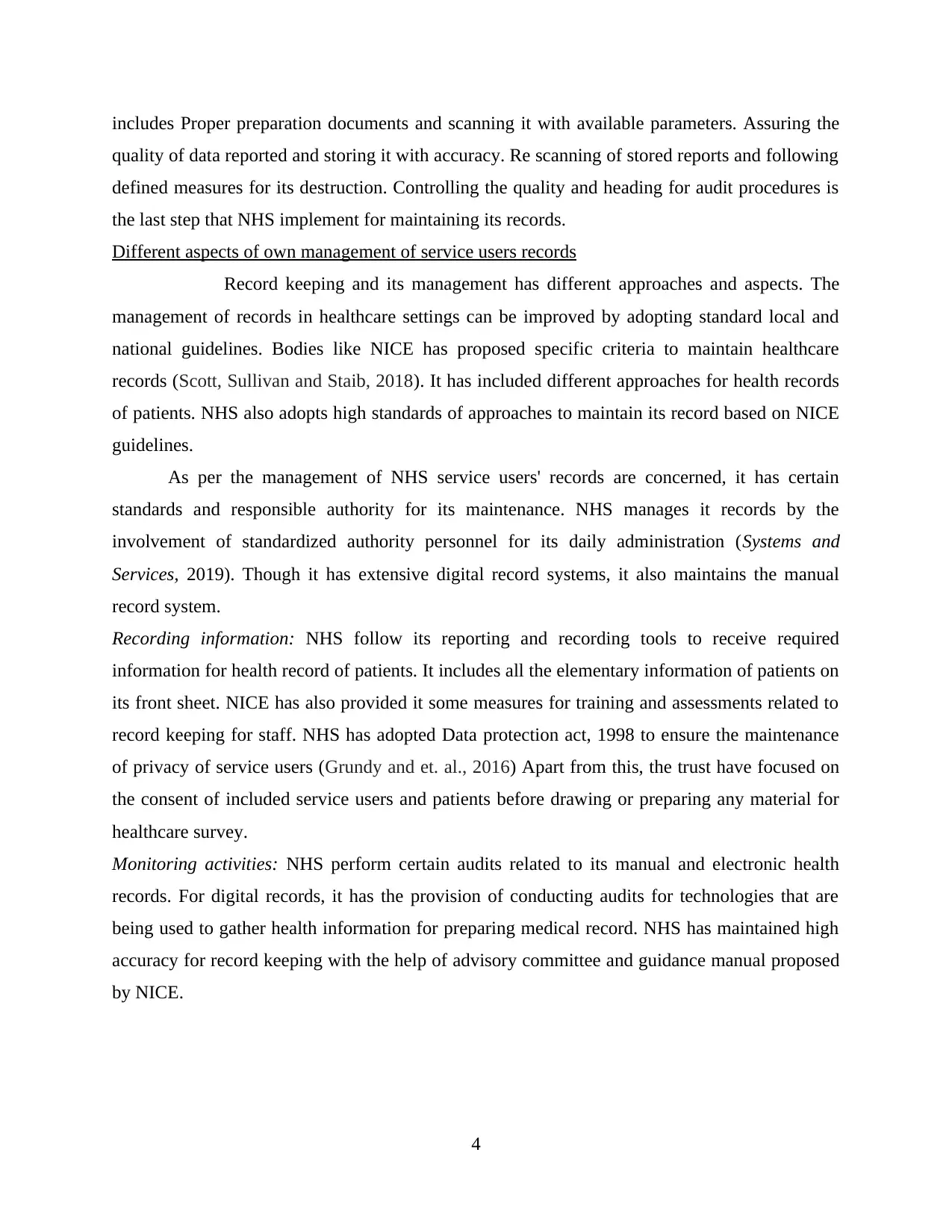
includes Proper preparation documents and scanning it with available parameters. Assuring the
quality of data reported and storing it with accuracy. Re scanning of stored reports and following
defined measures for its destruction. Controlling the quality and heading for audit procedures is
the last step that NHS implement for maintaining its records.
Different aspects of own management of service users records
Record keeping and its management has different approaches and aspects. The
management of records in healthcare settings can be improved by adopting standard local and
national guidelines. Bodies like NICE has proposed specific criteria to maintain healthcare
records (Scott, Sullivan and Staib, 2018). It has included different approaches for health records
of patients. NHS also adopts high standards of approaches to maintain its record based on NICE
guidelines.
As per the management of NHS service users' records are concerned, it has certain
standards and responsible authority for its maintenance. NHS manages it records by the
involvement of standardized authority personnel for its daily administration (Systems and
Services, 2019). Though it has extensive digital record systems, it also maintains the manual
record system.
Recording information: NHS follow its reporting and recording tools to receive required
information for health record of patients. It includes all the elementary information of patients on
its front sheet. NICE has also provided it some measures for training and assessments related to
record keeping for staff. NHS has adopted Data protection act, 1998 to ensure the maintenance
of privacy of service users (Grundy and et. al., 2016) Apart from this, the trust have focused on
the consent of included service users and patients before drawing or preparing any material for
healthcare survey.
Monitoring activities: NHS perform certain audits related to its manual and electronic health
records. For digital records, it has the provision of conducting audits for technologies that are
being used to gather health information for preparing medical record. NHS has maintained high
accuracy for record keeping with the help of advisory committee and guidance manual proposed
by NICE.
4
quality of data reported and storing it with accuracy. Re scanning of stored reports and following
defined measures for its destruction. Controlling the quality and heading for audit procedures is
the last step that NHS implement for maintaining its records.
Different aspects of own management of service users records
Record keeping and its management has different approaches and aspects. The
management of records in healthcare settings can be improved by adopting standard local and
national guidelines. Bodies like NICE has proposed specific criteria to maintain healthcare
records (Scott, Sullivan and Staib, 2018). It has included different approaches for health records
of patients. NHS also adopts high standards of approaches to maintain its record based on NICE
guidelines.
As per the management of NHS service users' records are concerned, it has certain
standards and responsible authority for its maintenance. NHS manages it records by the
involvement of standardized authority personnel for its daily administration (Systems and
Services, 2019). Though it has extensive digital record systems, it also maintains the manual
record system.
Recording information: NHS follow its reporting and recording tools to receive required
information for health record of patients. It includes all the elementary information of patients on
its front sheet. NICE has also provided it some measures for training and assessments related to
record keeping for staff. NHS has adopted Data protection act, 1998 to ensure the maintenance
of privacy of service users (Grundy and et. al., 2016) Apart from this, the trust have focused on
the consent of included service users and patients before drawing or preparing any material for
healthcare survey.
Monitoring activities: NHS perform certain audits related to its manual and electronic health
records. For digital records, it has the provision of conducting audits for technologies that are
being used to gather health information for preparing medical record. NHS has maintained high
accuracy for record keeping with the help of advisory committee and guidance manual proposed
by NICE.
4
⊘ This is a preview!⊘
Do you want full access?
Subscribe today to unlock all pages.

Trusted by 1+ million students worldwide
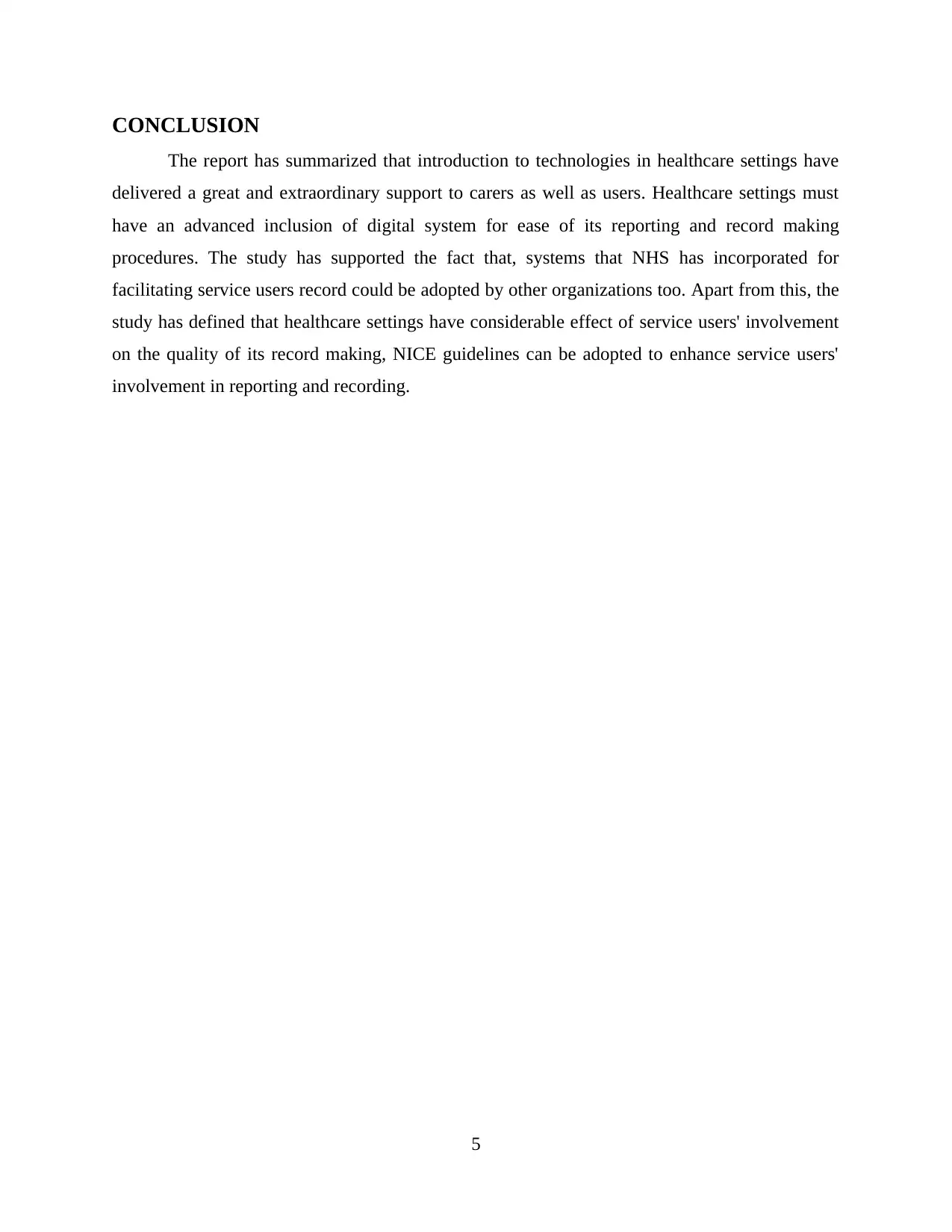
CONCLUSION
The report has summarized that introduction to technologies in healthcare settings have
delivered a great and extraordinary support to carers as well as users. Healthcare settings must
have an advanced inclusion of digital system for ease of its reporting and record making
procedures. The study has supported the fact that, systems that NHS has incorporated for
facilitating service users record could be adopted by other organizations too. Apart from this, the
study has defined that healthcare settings have considerable effect of service users' involvement
on the quality of its record making, NICE guidelines can be adopted to enhance service users'
involvement in reporting and recording.
5
The report has summarized that introduction to technologies in healthcare settings have
delivered a great and extraordinary support to carers as well as users. Healthcare settings must
have an advanced inclusion of digital system for ease of its reporting and record making
procedures. The study has supported the fact that, systems that NHS has incorporated for
facilitating service users record could be adopted by other organizations too. Apart from this, the
study has defined that healthcare settings have considerable effect of service users' involvement
on the quality of its record making, NICE guidelines can be adopted to enhance service users'
involvement in reporting and recording.
5
Paraphrase This Document
Need a fresh take? Get an instant paraphrase of this document with our AI Paraphraser
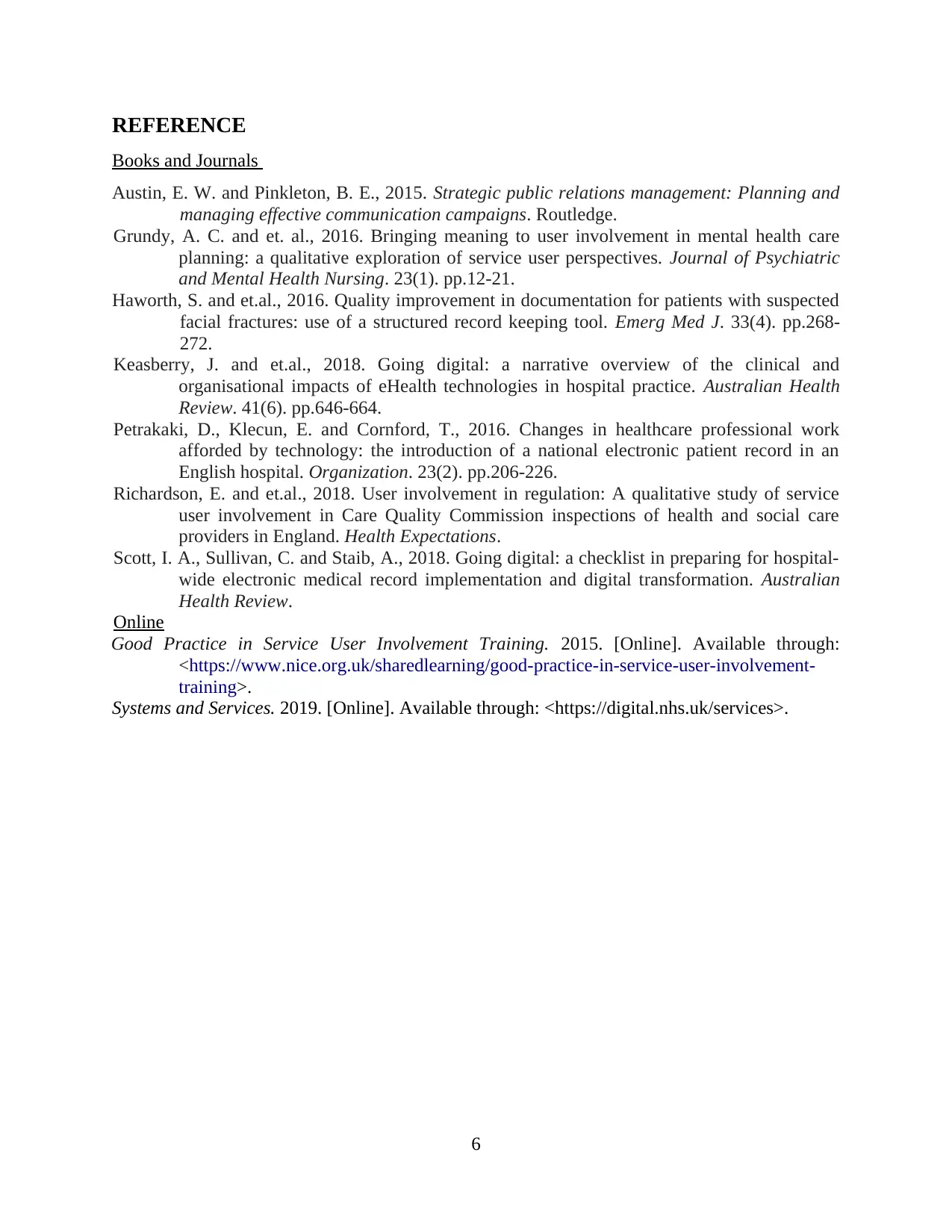
REFERENCE
Books and Journals
Austin, E. W. and Pinkleton, B. E., 2015. Strategic public relations management: Planning and
managing effective communication campaigns. Routledge.
Grundy, A. C. and et. al., 2016. Bringing meaning to user involvement in mental health care
planning: a qualitative exploration of service user perspectives. Journal of Psychiatric
and Mental Health Nursing. 23(1). pp.12-21.
Haworth, S. and et.al., 2016. Quality improvement in documentation for patients with suspected
facial fractures: use of a structured record keeping tool. Emerg Med J. 33(4). pp.268-
272.
Keasberry, J. and et.al., 2018. Going digital: a narrative overview of the clinical and
organisational impacts of eHealth technologies in hospital practice. Australian Health
Review. 41(6). pp.646-664.
Petrakaki, D., Klecun, E. and Cornford, T., 2016. Changes in healthcare professional work
afforded by technology: the introduction of a national electronic patient record in an
English hospital. Organization. 23(2). pp.206-226.
Richardson, E. and et.al., 2018. User involvement in regulation: A qualitative study of service
user involvement in Care Quality Commission inspections of health and social care
providers in England. Health Expectations.
Scott, I. A., Sullivan, C. and Staib, A., 2018. Going digital: a checklist in preparing for hospital-
wide electronic medical record implementation and digital transformation. Australian
Health Review.
Online
Good Practice in Service User Involvement Training. 2015. [Online]. Available through:
<https://www.nice.org.uk/sharedlearning/good-practice-in-service-user-involvement-
training>.
Systems and Services. 2019. [Online]. Available through: <https://digital.nhs.uk/services>.
6
Books and Journals
Austin, E. W. and Pinkleton, B. E., 2015. Strategic public relations management: Planning and
managing effective communication campaigns. Routledge.
Grundy, A. C. and et. al., 2016. Bringing meaning to user involvement in mental health care
planning: a qualitative exploration of service user perspectives. Journal of Psychiatric
and Mental Health Nursing. 23(1). pp.12-21.
Haworth, S. and et.al., 2016. Quality improvement in documentation for patients with suspected
facial fractures: use of a structured record keeping tool. Emerg Med J. 33(4). pp.268-
272.
Keasberry, J. and et.al., 2018. Going digital: a narrative overview of the clinical and
organisational impacts of eHealth technologies in hospital practice. Australian Health
Review. 41(6). pp.646-664.
Petrakaki, D., Klecun, E. and Cornford, T., 2016. Changes in healthcare professional work
afforded by technology: the introduction of a national electronic patient record in an
English hospital. Organization. 23(2). pp.206-226.
Richardson, E. and et.al., 2018. User involvement in regulation: A qualitative study of service
user involvement in Care Quality Commission inspections of health and social care
providers in England. Health Expectations.
Scott, I. A., Sullivan, C. and Staib, A., 2018. Going digital: a checklist in preparing for hospital-
wide electronic medical record implementation and digital transformation. Australian
Health Review.
Online
Good Practice in Service User Involvement Training. 2015. [Online]. Available through:
<https://www.nice.org.uk/sharedlearning/good-practice-in-service-user-involvement-
training>.
Systems and Services. 2019. [Online]. Available through: <https://digital.nhs.uk/services>.
6
1 out of 8
Related Documents
Your All-in-One AI-Powered Toolkit for Academic Success.
+13062052269
info@desklib.com
Available 24*7 on WhatsApp / Email
![[object Object]](/_next/static/media/star-bottom.7253800d.svg)
Unlock your academic potential
Copyright © 2020–2025 A2Z Services. All Rights Reserved. Developed and managed by ZUCOL.





